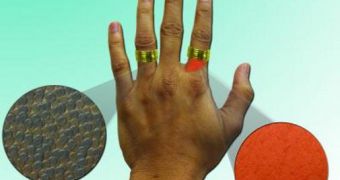Fighting common skin allergies may have just gotten easier. Scientists have developed a new approach to counteracting the reactions that exposure to common chemicals such as nickel produces in many people. The method is very simple, and the solution comes in the form of a cream.
Nickel allergy is one of the most common forms of skin allergy, and it affects around 10 to 15 percent of the general population in the United States, and elsewhere. In the US alone, that means around 30 to 45 million people cannot wear watches, chains or other common objects because they contain nickel.
The chemical is also used in cell phones, as well as in a host of other common, everyday objects. Over the years, people have used a variety of means to safeguard themselves for allergies, such as for example using nail polish to cover up the back of a watch.
But one cannot wear nail polish on fingertips, to avoid for example contact with nickel in coins. Solving this problem was the reason why experts at the Brigham and Women's Hospital conducted the new investigation in the first place.
They developed an approach based on nanoparticles, and published details of the technique in the April 3 early online issue of the top scientific journal Nature Nanotechnology. The method, they say, is the most effective to date in preventing this type of allergy.
Nickel-induced dermatitis can now be prevented through the use of a cream that contains nanoparticles carrying the chemical calcium. When applied on the skin in this form, these particles can bind to nickel, and prevent the chemical from making its way into the skin.
“There have been approaches to developing creams with agents that bind the nickel before it can penetrate the skin, but these are not effective in most patients and can even be toxic when the agents themselves penetrate the skin, as most do,” explains Jeffrey Karp.
He is the leader of the new study, and also the co-director of the BWH Center for Regenerative Therapeutics at BWH. He is also based at the Harvard Medical School, the Harvard Stem Cell Institute (HSCI), and the Harvard-MIT Division of Health Sciences and Technology (HST).
Together with HMS and Massachusetts General Hospital (MGH) dermatologist R. Rox Anderson, the expert found that, while the calcium nanoparticle-based creams are efficient at absorbing nickel, the nanoparticles themselves cannot penetrate human skin.
“Despite barrier creams, anti-inflammatory drugs, and attempts to avoid nickel, this [metal] is still the most common cause of allergic skin reactions,” Anderson explains.
“Nanoparticles that bind to [the nickel] allergens but do not penetrate the skin offer a new strategy. Big hope in a small package1” he goes on to say.

 14 DAY TRIAL //
14 DAY TRIAL //